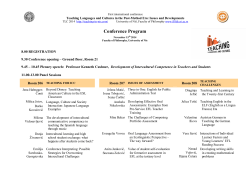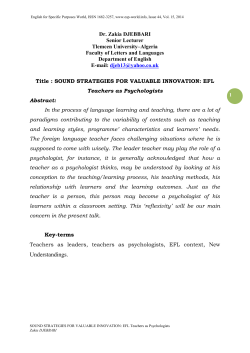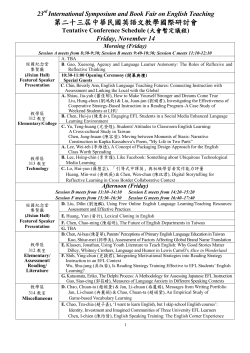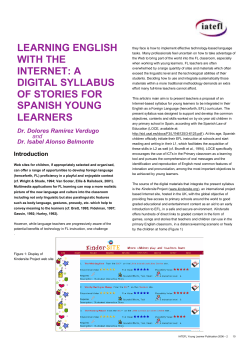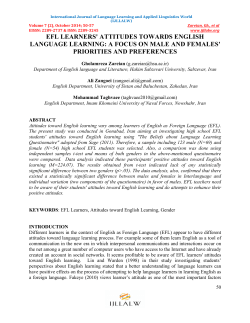
Full Paper - IJ-ELTS
IJ-ELTS: International Journal of English Language & Translation Studies Vol: 1, Issue: 2 Metaphors about EFL Teachers' Roles Akbari, Mohsen Metaphors about EFL Teachers' Roles: A Case of Iranian NonEnglish-Major Students Mohsen Akbari Department of English Literature and Language Teaching, Ilam University, Ilam, Iran Abstract Following cognitive views to language pedagogy; there have been considerable studies particularly in English-as-a-Foreign-Language (EFL) contexts via metaphor analysis as a reflective research tool. Considering the inadequate attempts in an Iranian EFL environment, the present study seeks to unpack metaphorical reflections by a group of Iranian non-English-major university students about EFL teachers' roles. To this end, a metaphor elicitation questionnaire was administered to a convenient sample of 187 Iranian bilingual (Kurdish-Persian) university students majoring different disciplines at three public and private universities in Ilam. Using content analysis, the metaphorical expressions collected via completion of the metaphor prompt "An English language teacher is (like) …. because …." were structured into dominant thematic categories for further analysis. The metaphors were also examined to determine whether they fit into the design of current language teaching and learning approaches and methods. Generally, the results revealed that the metaphorical images were comparatively for and against several proposed models of language learning and teaching about EFL teachers' roles. There were also several pedagogical implications for teacher education programs as well as suggestions for further investigations. Keywords: Metaphor, Language teacher's roles, Bilingual, Iranian, University students International Refereed & Indexed Journal of English Language & Translation Studies ISSN: 2308-5460 July-September, 2013 www.eltsjournal.org 100 IJ-ELTS: International Journal of English Language & Translation Studies Vol: 1, Issue: 2 Metaphors about EFL Teachers' Roles Akbari, Mohsen 1. Introduction During the last two decades, with the rise of cognitive views towards language pedagogy as well as inclination to student-centered learning and learners' personal characteristics, a number of growing studies (see e.g. e.g. Bernat, 2006; Buyukyazi, 2010; Yazici and Tan, 2010; Ghabanchi and Meidani, 2012) have focused on learners' beliefs; that are, common assumptions learners hold about the nature of language learning, the language learning process, the roles of language learners and teachers (Bernat &Gvozdenko, 2005). Since the belief system of language learners about different aspects of language learning and teaching plays a decisive role in their success and failure (Pishghadam, Fatemi, Torghabeh & Navari, 2011), understanding different kinds of learners' beliefs and ideas which shape and organize the ways they perceive language learning and teaching is among the leading requirements in the process of language pedagogy (Bernat &Gvozdenko, 2005; Ahkemoglu, 2011). According to Farjami (2012), good steps have been taken to understand language learners thinking and ideologies. Among many procedures employed, one of the recently introduced indirect ways to uncover the implicit belief system of language learners is through an analysis of metaphors (Ellis, 2003; Pishghadam et al., 2011). Metaphors are a cognitive and reflective means for people to utilize association, comparison and resemblance (Ahkemoglu, 2011) in order to filter reality through their own mental images of real world phenomena and to communicate their beliefs in an expressible and compact way (Pishghadam et al., 2011; Nikitina and Furouka, 2008). As a whole, metaphors can serve as a justified instrument that systematizes language learners' meaning and action, and provides insights into complex concepts of language teaching and learning (Lin, Shien& Yang, 2012). In Iran, like other parts of the world, the number of students, who want to learn English as a foreign language (EFL), is increasing day by day. Although learnercentered language learning procedures are recently adopted in Iranian EFL context; Iranian language learners, learning English via current language learning and teaching approaches and methods led by language teachers, need to be privileged by such classes that can provide them with skillful teachers who can handle the language classes in a productive way. Therefore, there is a dire need to take language teachers' roles into account in various socio-cultural and educational settings (Oxford et al., International Refereed & Indexed Journal of English Language & Translation Studies ISSN: 2308-5460 July-September, 2013 www.eltsjournal.org 101 IJ-ELTS: International Journal of English Language & Translation Studies Vol: 1, Issue: 2 Metaphors about EFL Teachers' Roles Akbari, Mohsen 1998; Nikitina & Furuoka, 2008) like Iran in order to have a more successful language educational system and deal with language learning problems. 2. Literature Review Recently, a number of studies have employed metaphor analysis as a reflective research tool with the assumption that our thought processes are largely metaphorical in nature (Ahkemoglu, 2011; Lin et al., 2012) to examine metaphorical images and attitudes towards language learning, classroom practices, teacher-student roles and the other. The majority of studies on metaphor analysis in EFL contexts (see e.g. Ellis, 2003; Zapata & Lacorte, 2007; Mello, Damianovic & Ninin, 2007; Erkmen, 2010; Lin ,Shien& Yang, 2012) have focused on metaphorical reflections spelt out by teachers, not the language learners themselves except for a few studies. For example, using a self-designed open-ended questionnaire as well as a combined model of content analysis, Nikitina and Furouka (2008) examined metaphors by a group of 23 multilingual Malaysian university students. The results revealed that the imagery used in the metaphors was, to some extent, gender-related and EFL teachers were viewed as caretakers, givers and essential elements in the domain of language pedagogy. Torghabeh, Elahi, and Khanalipour (2009) elicited metaphorical concepts from Iranian participants and categorized them in nine conceptual metaphors including provider of knowledge, friend, organizer, nurturer, spiritual leader, parent, entertainer, counselor, and innovator. They also took into account the metaphors mentioned by teachers. In an EFL Turkish context, Ahkemoglu (2011) employed metaphor analysis to explore the conceptual metaphors of both English-major and non-English-major learners in regard to their perception of an English language teacher. In addition, the study searches into the similarities and/or discrepancies between these two groups of learners in how they perceive an English language teacher. Data were collected through metaphor elicitation sheet, semi-structured interviews, and personal essays. The main results of the study indicated that while some metaphors are peculiar to English language teacher such as oracle, schizophrenic, and gum, some metaphors seem to be common with the ones developed for the concept of a teacher such as light, guide and bridge. Wan, Low, and Li (2011) conducted a study about how a group of university teachers and learners viewed teachers' roles in their metaphorical conceptualization via metaphor prompt International Refereed & Indexed Journal of English Language & Translation Studies ISSN: 2308-5460 July-September, 2013 www.eltsjournal.org 102 IJ-ELTS: International Journal of English Language & Translation Studies Vol: 1, Issue: 2 Metaphors about EFL Teachers' Roles Akbari, Mohsen "An English teacher is ……. because……" to represent their beliefs. Data sources also included follow-up individual interviews. The results identified mismatches regarding the interpretations of teachers' roles both between students and teachers. Generally, the review of the studies indicated that more supplementary studies are required to fill the gap. In line with previous research, the present exploratory study conducts a metaphor analysis about EFL teachers' roles employing a group of Iranian bilingual (Kurdish-Persian) non-English-major university students learning English as foreign language in their local academic context, an overlooked setting among the previous studies which have been mostly conducted in monolingual socio-cultural contexts. It focuses on the analysis of the metaphors about language teachers' roles produced by the learners. Such explorations of EFL learners' perceptions of the language teachers may widen our perspective of what being a teacher means (Ellis, 2003; Nikitina & Furouka, 2008). 2.1 Purpose of the Study Following previous studies, the major aim of this study is to put language learners in situations to provide metaphors expressing their hidden beliefs and ideas about language teachers' roles and analyzing those metaphors in an Iranian bilingual context wherein university students are learning EFL. Therefore, the present study is to address the following research questions: 1. What metaphorical images do Iranian bilingual (Kurdish-Persian) EFL learners provide to describe their language teachers' roles? 2. To what extent do the metaphors produced by the participants are for or against current language learning and teaching approaches and methods? 3. Methodology 3.1 Participants The convenient sample of the current study consisted of 187 Iranian bilingual (Kurdish-Persian) non-English-major university students (54% male and 46% female) majoring in different disciplines from three public universities in Ilam, on the west of Iran, in the second semester of the academic year 2012-2013. Participation was on a voluntary basis although they were screened out regarding their history of bilingualism to meet the requirements and validity of the study. The age of the International Refereed & Indexed Journal of English Language & Translation Studies ISSN: 2308-5460 July-September, 2013 www.eltsjournal.org 103 IJ-ELTS: International Journal of English Language & Translation Studies Vol: 1, Issue: 2 Metaphors about EFL Teachers' Roles Akbari, Mohsen participants was between 18 and 24 years with the mean age of 19.5. They all were studying English since their secondary school. 3.2 Instrument and Procedure A self-designed metaphor elicitation sheet with an incomplete sentence written in Persian as the academic language of the students reads in English "A language teacher is (like) …….. because ……. ." adopted from Lawley and Tompkin (2004), who suggest asking simple questions to elicit students' metaphors was distributed in classes at the end of the second semester of the academic year 2012/2013. The students were asked to complete the task at home as this gave them sufficient time for reflection. The participants were free to use the formal academic language (Persian) or even their mother tongue (Kurdish) in developing their metaphors if they wished to as it was believed that using the target language (English) might cause some learners to have difficulty in generating metaphors and expressing themselves in the correct way. They were told that their participation was entirely voluntary and that their responses would remain anonymous and that confidentiality would be maintained. In addition, interviews were conducted to gain more in-depth responses from the participants, and to find out about the participants' underlying reasons for the metaphors they offered. All the interviews were tape recorded and then translated into English and analyzed by the researcher. To organize the data, the metaphors generated by the students were translated into English and listed thematically. As the final step of the analysis, the metaphors were examined in terms of their similarity or discrepancy with current language learning and teaching approaches and methods. The reason behind selecting a framework for comparison was the very nature of metaphor that exerts a kind of subjectivity on the researcher (Pishghadamet al., 2011). 4. Discussion and Results Ten groups of metaphorical themes were obtained out of the metaphorical images and their entailments provided by the participants of the current study. The metaphors about EFL teachers' roles produced by Iranian non-English-major students with their frequency and entailments were as follows: International Refereed & Indexed Journal of English Language & Translation Studies ISSN: 2308-5460 July-September, 2013 www.eltsjournal.org 104 IJ-ELTS: International Journal of English Language & Translation Studies Vol: 1, Issue: 2 Metaphors about EFL Teachers' Roles Akbari, Mohsen The first group with the highest number of images (26.73%) was summarized thematically into "EFL teacher as a guide" combined out of several metaphors such as coach, director, manager, book, police officer and foreman. The entailments for these metaphors and figurative images were that an EFL teacher helps us to learn speaking in a new language; directs us to the best strategies of learning English; and guides us to correct mistakes and kick goals. The second category of metaphorical concepts with the highest number of images (20.32%) for EFL teachers' roles were grouped into the theme "EFL teacher as a professional" composed of metaphors such as genius, mastermind, scientist, inventor and professor. The entailments for this category were that an EFL teacher is a knowledgeable person who knows about different aspects of English; is a brainy man who plans everything in English; and is a skillful person who invents different strange things. The third group of metaphorical images (17.11%) was entitled as "EFL teacher as a devil" comprised of metaphorical images such as non-human killer, monster, alien, a strange being and dragon. The entailments for this category were that an EFL teacher is a stranger who tortures language learners; is a dangerous creature that has come from another planet with a disgusting language; and is a frightening creature that hurts and kills the innocent learners. Another category of concepts (10.69%) produced by non-English-major participants were in contrast with the afore-mentioned category. The metaphorical conceptualizations in this group thematically named "EFL teacher as an angel" included images such as a kind person, a charitable person, an angel and a caring individual. The entailments for this category were that an EFL teacher is a kind person who takes care of language learners; is a patient person who speaks kindly to help learners; and is a heavenly angel who gives lots of gifts to the learners. The fifth and the sixth metaphorical groups of images pictured by Iranian nonEnglish-major students entitled as "EFL teacher as a parent" (9.62%) and "EFL teacher as a natural element" (8.64%) included metaphorical concepts such as dad, father, mother and sun, rain, mountain, water, respectively. The entailments for the former category pictured that an EFL teacher is like a dad who tries hard to manage our lives and takes cares of his children; is like a mother who cares her children; and International Refereed & Indexed Journal of English Language & Translation Studies ISSN: 2308-5460 July-September, 2013 www.eltsjournal.org 105 IJ-ELTS: International Journal of English Language & Translation Studies Vol: 1, Issue: 2 Metaphors about EFL Teachers' Roles Akbari, Mohsen is like a mother who does her best to bring up the best language learners. The entailments for the latter category illustrating EFL teachers in the form of natural elements were that an EFL teacher is like sun that shines and gives energy and growth to everything; is like water that is vital in learning English; and is a mountain that stands in front of problems and gives the best gifts to us. There was another category of metaphors about EFL teachers' roles, "EFL teacher as a machine" (4.27%) which included images such as robot, talking machine, translating machine, and radio. The entailments for these images were that an EFL teacher is a radio that broadcasts different programs with a strange language; is a translating machine that can translate everything; and is an automaton that is programed to teach English. Finally there were two groups of metaphorical images provided by Iranian nonEnglish-major students categorized into thematic headings including "EFL teacher as a creator" (2.13%)and "EFL teacher as a wet blanket" (0.53%). The images for these categories were artist, builder, maker and a bore, respectively. The entailments for the former were that an EFL teacher is a builder who works hard to make a construction; is an artist who beautifully pictures English in the minds of language learners, and for the latter category, the entailment was that an EFL teacher is a boring person who is unbearable. As a whole, the findings were illustrated in Figure 1. Figure: 1 An illustration of metaphorical themes generated by Iranian non-Englishmajor university students Metaphorical Themes 30 25 20 15 10 5 0 International Refereed & Indexed Journal of English Language & Translation Studies ISSN: 2308-5460 July-September, 2013 www.eltsjournal.org 106 IJ-ELTS: International Journal of English Language & Translation Studies Vol: 1, Issue: 2 Metaphors about EFL Teachers' Roles Akbari, Mohsen The qualitative analysis of the metaphors generated by the participants in the present study showed that the Iranian non-English-major university students hold relatively positive and negative perceptions of language teachers' roles. The metaphors produced by the students were diverse and were similar to the images generated by language learners in other educational contexts, for example, EFL teacher as a parent and EFL teacher as an essential element (Nikitina & Furuoka, 2008) in a Malaysian EFL context; as well as EFL teacher as a guide (Wan et al, 2011) in a Chinese EFL setting. In the current study, "EFL teacher as a guide" was the most recurrent metaphorical concept produced by the students. This fact reveals that the non-English-major university students learning English as their third language perceived their EFL teachers teaching in a unique bilingual context as counselors who provided not only knowledge but also helped the students to tackle language learning problems. This metaphor is an indication of the language learning needs of university learners and their inclination to meet their needs. Obviously, they would appreciate a language classroom with a language teacher who manages and directs the EFL class environment and provides the students with the best strategies and skills. This category of metaphors about EFL teachers' roles was in consonance with metaphors produced by Chinese EFL learners (Wan et al., 2011) "EFL teacher as a professional" was the second highest category of metaphors. This metaphorical concept demonstrates that Iranian university students view their EFL teachers as knowledgeable individuals who are as experts in their fields and are a mine of information. Clearly, Iranian university students learning EFL prefer language teachers who are prestigiously informative and provide them with the knowledge of the new language they are learning. This category was in agreement with the metaphors produced by Malaysian EFL students (Nikitina & Furuoka, 2008). The third highest metaphorical category which was kind of negative was "EFL teacher as a devil". This metaphorical theme uncovers the fear and hatred of some Iranian EFL learners of language learning and teaching process. Obviously, nonEnglish-major university students view learning a language as a dangerous torturing activity and the EFL teacher as a monster or a killer. This negative ideology about the roles of EFL teachers in this bilingual context reflects the probable impacts of several International Refereed & Indexed Journal of English Language & Translation Studies ISSN: 2308-5460 July-September, 2013 www.eltsjournal.org 107 IJ-ELTS: International Journal of English Language & Translation Studies Vol: 1, Issue: 2 Metaphors about EFL Teachers' Roles Akbari, Mohsen affective variables such as inhibition, anxiety, lack of self-esteem and motivation, and fear of language learning. This metaphorical concept generated by learners shows that they are frustrated by the way English language classes are presented to them which may eventually discourage them to pursue learning English. In addition, this shows that in this local context EFL teachers may not equip learners with enough motivations or abilities to deal with the learning process. As a whole, this paints a blameworthy picture of EFL teachers and the current situation of language learning and teaching in Iran. The results obtained were also examined in terms of their similarity of discrepancy with current designs of language learning and trenching approaches and methods. The three most dominant metaphorical categories produced by Iranian non-English-major university students with the highest percentages about EFL teachers' roles were "EFL teacher as a guide", "EFL teacher as a professional" and "EFL teacher as a devil", respectively. Examining the metaphors with the design of the current language learning and teaching method and approaches revealed that the highest group of metaphorical concepts, "EFL teacher as a guide" was in line with the design of Curren's method, Community Language Learning, wherein EFL teachers consider students as whole persons with intellect, feelings, instincts, physical responses, and desire to learn. Teachers also recognize that language learning can be threatening. By understanding and accepting students' fears, teachers help students feel secure and overcome their fears, and thus help them harness positive energy for learning (Snow, 1992, Rodgers, 2001). This metaphorical picture was against the assumed role for an EFL teacher in Grammar-Translation and Audio-Lingual methods, that is, an EFL teacher as a firm model who controls all the language learning process and EFL learners' behavior in the classroom context (Snow, 1992; Rodgers, 2001). Therefore, it is implied that employing such classic methods would not meet EFL learners' need in such a bilingual context. The second highest category, "EFL teacher as a professional" was in consonance with Direct Method and Communicative Approach wherein the language teacher directs and facilitates class activities, but students and teacher are partners in the teaching/learning process (Snow, 1992). It was also in line with a language teachers' International Refereed & Indexed Journal of English Language & Translation Studies ISSN: 2308-5460 July-September, 2013 www.eltsjournal.org 108 IJ-ELTS: International Journal of English Language & Translation Studies Vol: 1, Issue: 2 Metaphors about EFL Teachers' Roles Akbari, Mohsen role in Community Language Learning in which a language teacher routinely probes for students' feelings about learning and shows understanding, helping them overcome negative feelings (Snow, 1992; Rodgers, 2001). The final dominant metaphorical category, "EFL teacher as a devil", was in favor of the view towards EFL teachers' roles wherein teacher gives commands and students follow them in Total Physical Response method (Snow, 1992; Rodgers, 2001). This picture was against the presumed role for an EFL teacher in Suggestopedia as a language learning and teaching approach. In this approach, teacher has authority, commands trust and respect of students; teacher desuggests negative feelings and limits to learning; if teacher succeeds in assuming this role, students assume childlike role, spontaneous and uninhibited (Snow, 1992). It was also against the EFL teacher' role in Community Language Learning in which teacher acts as a counselor, supporting students with understanding of their struggle to master language in often threatening new learning situation (Snow, 1992). Teacher routinely probes for students' feelings about learning and shows understanding, helping them overcome negative feelings (Snow, 1992). As a whole, the examinations of dominant metaphorical themes about EFL teachers' roles among Iranian non-English-major university students are oriented towards current language learning and teaching approaches and methods including Community Language Learning Method and Communicative Approach. 5. Conclusion and Implications In sum, the current study adds to current research on the usefulness of metaphor analysis as a reflective tool in which researchers attempt to elicit EFL learners' beliefs. The analysis of the metaphors about language teachers can shed light on the way the learners conceptualize their learning process and the things that they consider as rewarding or hindering in the learning journey (Pishghadam & Navari, 2011; Lin et al., 2012). The study reported here was an attempt to analyze EFL teachers' roles employing Iranian bilingual (Kurdish-Persian) non-English-major university students learning English as foreign language in their local academic context. The three most dominant metaphorical categories produced by Iranian university students about EFL teachers' roles including "EFL teacher as a guide", "EFL teacher as a professional" International Refereed & Indexed Journal of English Language & Translation Studies ISSN: 2308-5460 July-September, 2013 www.eltsjournal.org 109 IJ-ELTS: International Journal of English Language & Translation Studies Vol: 1, Issue: 2 Metaphors about EFL Teachers' Roles Akbari, Mohsen and "EFL teacher as a devil" should be taken into account by EFL teachers and teacher educators in this local context. Teachers' awareness of these pictures, and accordingly of learners' thought processes, is necessary because teachers are the usual initiators and facilitators of learning and their satisfactory teaching of a language may be highly dependent on their knowledge of learners conceptions and misconceptions about language learning and teaching process (Lin et al., 2012; Farjami, 2012).Identifying, evaluating and critiquing learners’ conceptual metaphors and applying the insights to practice can go a long way in affecting, among other things, learners' attitude and their language learning strategies and styles (Fajami, 2012). By exploring these ideas, learners can become aware of the feelings existing implicitly in their minds (Pishghadam & Navari, 2011). Since one of the orientations of the current study was towards examinations of metaphors produced with current language learning and teaching approaches and methods, it was revealed that language teachers should not personally prefer to practice one of the methods to the exclusion of others. Rather, EFL teachers should be aware of language learners' ideologies and adapt the best teaching methods and approaches to meet the learners' need and tackle the likely language learning problems. There were also several limitations in the present study. First of all, the number of bilingual participants was rather limited, and they were all from a specific region in Iran. Therefore, a bigger sample size might yield slightly different or more significant results. Secondly, the participants' language proficiency, gender, and university majors were not included in this research. These variables could change the metaphors about EFL teachers' roles (Nikitina & Furuoka, 2008). For future research, it could be insightful to explore whether metaphors about language teachers created by language learners with different language proficiencies would differ from those obtained in this inquiry (Ellis, 2003; Farjami, 2012). In addition, examination of metaphors based on gender and university major variables would lead to interesting results. Finally, the comparison of metaphors about EFL teachers' roles generated by EFL learners and teachers and their probable interactions would have more pedagogical values for language education programs (Wan et al, 2011). International Refereed & Indexed Journal of English Language & Translation Studies ISSN: 2308-5460 July-September, 2013 www.eltsjournal.org 110 IJ-ELTS: International Journal of English Language & Translation Studies Vol: 1, Issue: 2 Metaphors about EFL Teachers' Roles Akbari, Mohsen About the Author Mohsen Akbari works as a member of faculty with the Department of English Literature and Language Teaching, Ilam University, Ilam, Iran. His areas of research interest include- ELT, ESP and Teaching English as a Foreign Language. He has also published widely in various international journals. References Ahkemoglu, H. (2011). A study on metaphorical perceptions of EFL learners regarding foreing language teacher.Unpublished Master Thesis: CukurovaUniverisity Institute of Social Sciences: Turkey.Retreived on Jan 3th, 2013 from library.cu.edu.tr/tezler/8585.pdf. Bernat, E., &Gvozdenko, M. (2005). Beliefs about language learning: Current knowledge,pedagogical implications and new research directions. TESL-EJ,9(1), 1-21. Bernat, E. (2006). Assessing EAP learners' beliefs about language learning in the Australian context.Asian EFL Journal, 8 (2), 220-227. Buyukyazi, M. (2010).The beliefs of university foreign language students and their teachers about language learning.SosyalBilimler, 8 (10), 169-182. Ellis, R. (2003). A metaphorical analysis of learner beliefs.In P. Burmeister, T. Piske and A. Rohde (eds.), An Integrated View of Language Development: Papers in Honor of Henning Wode, Trier, Germany: WissenschaftlicherVerlag. Erkmen, B. (2010). Non-native novice EFL teachers' beliefs about teaching and learning.Unpublished Master's Thesis: University of Nottingham: the UK.Retrieved on Feb 4th, 2013 from www.etheses.nottingham.ac.uk/1458/1/whole_thesis_final_june_2010.pdf. Farjami, H. (2012). EFL students' images and metaphors of grammar learning.Iranian Journal of Applied Linguistics, 15(1), 19-41. Ghabanchi, Z. &Meidani, E. N. (2012). Beliefs about language learning and strategy use: the case of Iranian non-English majors. World Journal of English Language, 2 (1), 21-30. Lawley, J., &Tompkin, P. (2004).Metaphors in mind: Transformation throughsymbolic modeling. New York: Crown House Publishing. Lin, W., Shein, P., & Yang, S. (2012). Exploring personal EFL teaching metaphors in pre service teacher education.English Teaching: Practice and Critique, 11(1). Mello, D., Damianovic, M. C., Ninin, M. O. (2007). Metaphors as a source of teachers' representations.Letras&Letras, Uberlandia, 23 (1), 37-54. Nikitina, L. &Furuoka, F. (2008). "A language teacher is like…": examining Malaysian students’ perceptions of language teachers through metaphor analysis. Electronic Journal of Foreign Language Teaching, 5(2), 192-205. Oxford, R., Tomlinson, S., Barcelos, A., Harrington, C., Lavine, R.Z., &Saleh, A. (1998). Clashingmetaphors about classroom teachers: Toward a systematic typology for the language teaching field. System26(1), 3–50. International Refereed & Indexed Journal of English Language & Translation Studies ISSN: 2308-5460 July-September, 2013 www.eltsjournal.org 111 IJ-ELTS: International Journal of English Language & Translation Studies Vol: 1, Issue: 2 Metaphors about EFL Teachers' Roles Akbari, Mohsen Pishghadam, R., Fatemi, A. H., Torghabeh, R. A., &Navari, S. (2011). Qualitative metaphor analysis and language learning opportunities.Iranian Journal of Applied Linguistics,14(1), 77- 108. Pishghadam, R. &Navari, S. (2010) .Examining Iranian language learners' perceptions of language education in formal and informal contexts: a quantitative study.Modern Journal of Applied Linguistics, 2(1), 171-185. Rodgers, T. S. (2001). Language teaching methodology. Retrieved on Feb 14th, 2013 from www.cal.org/resources/digest/rodgers.html Snow, D. (1992). Eight approaches to language teaching. Retrieved on Jan 7th, 2013 from www.cal.org/resources/digest/eightapproaches.html. Torghabeh, R.A., Elahi, M., &Khanalipour, S. (2009).Examining Iranian EFL learners' and teachers' beleifs about teachers through metaphor analysis. Iranian EFL Journal, 5, 115-138. Wan, W., Low, G.D., & Li, M. (2011). From students' and teachers' perspectives: metaphor analysis of beliefs about EFL teachers' roles. System, 39(3), 1-13. Yazici, I. C. & Tan, B. (2010). Beliefs about language learning: A study of Turkish university students learning English. International Journal of Arts and Sciences, 3 (10), 73-81. Zapata, G., &Lacorte, M. (2007).Pre-service and in-service instructors’ metaphorical constructions ofsecond language teachers.Foreign Language Annals, 40(3), 521–534. International Refereed & Indexed Journal of English Language & Translation Studies ISSN: 2308-5460 July-September, 2013 www.eltsjournal.org 112
© Copyright 2025
